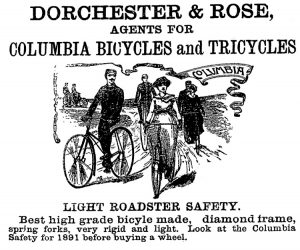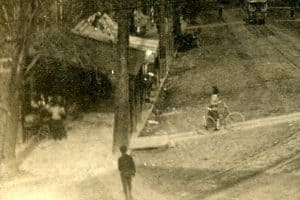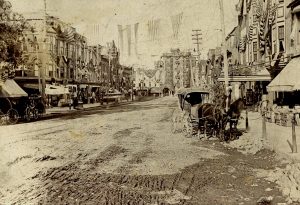As Modest on a Wheel as in a Drawing Room: Female Bicyclists in the 1890s
By Alice Askins, Education Coordinator at Rose Hill Mansion
In the 1880s, high-wheel bicycles came to Geneva. By the 1890s, a new style of bike had made cycling possible for slightly less daring people. The new “safety” bicycle had a chain drive – it allowed a gear ratio independent of the wheel size. This meant that a bike could go faster even with a smaller front wheel, without the rider having to pedal faster. Another innovation was a pneumatic tire, which enabled smaller wheels to give a smooth ride.
We see the new style of bike in the ads for Dorchester and Rose. The Geneva Advertiser, July 21, 1891:

There is a high wheeler in the back, but the couple in front is riding the new bicycles. There are two women riding – the lady in front, and the lead rider on the tandem in the background. There may be a third woman in the far distance.
The advertisers were happy to show women on bikes – they could sell more bikes, if females as well as males were riding. Some people, however, were not so sure that women had any business on bicycles. The Geneva papers seem to have looked on cycling women favorably, but the fact that they kept saying so suggests that the argument went on for a while. In September 1894, the Daily Gazette reprinted a piece from the New York Tribune:
There is a good deal of talk . . . adverse to the use of the bicycle by women. The charge that it is immodest . . . is not deserving of serious attention. A modest woman is as modest on a wheel as in a drawing-room; and even if she wears what are collectively classed as “bloomers” her costume is not as deserving of notice as the bathing suits which women wear unchallenged at all our seaside resorts. The question whether bicycle-riding is injurious to women’s health is a most important one; the answer can only be given as the result of experience. Undoubtedly harm has been caused by excessive riding; but so it may be caused by too much walking or rowing. . . . the bicycle rightly employed will in all probability promote health and happiness.
The next month, the Gazette printed a variety of opinions favorable to women riding bicycles:
Boston Globe. – Bishop Coxe is outvoted six to one. Francis E. Willard, Kate Field, Lady Henry Somerset, Jeannette Gilder, Mrs. M. E. Sherwood and Dr. Grace Peckham Murray have all written to the New York World that bicycle riding for women is not immodest. That settles it, of course.
Springfield Union. – The popular verdict . . . agrees with the opinion of these well-known women, and girls and women may ride the bicycle as much as they please. If there are still some prudes who do not like the looks of a woman on a wheel they should look in some other direction. . . .
Boston Transcript. – . . . Certainly women are seldom seen on a bicycle who deserve the cruel and indecent caricaturing to which feminine bicyclists have been exposed. Many riders are ungraceful, it is true, but there are plenty of ungraceful and ridiculous people on foot, men and women too, as well as on wheels.
The Geneva Daily Times agreed. In June 1895, it reported that the Women’s Rescue League of Boston had resolved that “the bicycle woman” disgraced “the true womanly woman.” The Times quoted the Buffalo Express, assuring women who were worried about this:
Image of Seneca Street captures a woman walking her bike across the road. There is another woman with a bike on the left in this detail.
You . . . are just as good and modest a girl as you were before you tried the wheel. Remember that the bicycle is really just about as potent for evil as the village pump . . . We think that the fan is a far more dangerous device . . . The handkerchief has frightful resources of iniquity . . . the comparatively few but talkative . . . objectors-at-large . . . who put ‘panties’ on their statuettes, and go about the world discovering ways and means for being shocked . . . are just now talking bicycle . . . they’ll tire of it soon . . .
Naturally, the clothes women wore for riding were another concern of the objectors-at-large. The Geneva papers were not so sure that bloomer costumes were proper – in June 1895, the Gazette printed a story about how a women’s brother brought her a cycling outfit from Paris, with no skirt to it. Unwilling to hurt her brother’s feelings, the woman went out for a ride with him in her new bloomer suit, but was miserable with embarrassment and brutally condemned by her alleged best friend. The Times, though, reported the following month:
Two-thirds of the riders who still wear skirts on the wheel wear knickerbockers under them. Chicago women, like those of Paris, seem to favor bloomers. Skirts are deemed an inexcusable nuisance. . . . One woman says: “I didn’t believe in bloomers till my skirts caught between my chain and sprocket wheel and threw me off on a railroad crossing, but I do now. I didn’t ride after that accident until I got bloomers.
The concern that seems silliest to us today was that women might affect their future babies by riding. The Gazette explained this in July 1895:
Sit straight on your bicycle. There is a story . . . that should lead all riders . . . to heed this admonition. [A pair of enthusiastic cyclers married and had a baby. Sadly, the infant] is bent like a tightly drawn bow . . . a prominent physician gives an account of the birth of a child . . . which . . . had marked deviation from a perfect body above the waist, notably a curvature of the spine and a contraction of the breast into the shape which riders are apt to take on their wheels. Investigation proved that both father and mother were passionately fond of the wheel . . . [Furthermore, while the mother was pregnant, she attended a bike tournament and] excitedly watched hundreds of racers on their wheels, bent over in the attitude customary in bicycle contests. Thus the physician says that, if care is not taken, we will be apt to have a new and distinctively humped-over race of beings in the future, all proceeding from carelessness in riding the bicycle.
Quite a few cycling mothers must have been relieved when their babies were born with normal spines.
While much of the discussion in the local papers was reprinted from other journals, we do have some evidence of local women riding. The the Gazette reported in July 1895 (a summer notable for bicycling references) we find this account.
1892 photo of Seneca Street gives some idea of Geneva streets at the time.
Have Bicyclists any Rights? On the morning after a recent heavy rain one of our townswomen was riding her wheel slowly along the west side of South Exchange street. She intended to cross diagonally at the Bank corner and go north on the east side of Exchange street. Just as she reached the corner a young man came from the west on Seneca street. The woman rode still more slowly, but the man seemed to want to be in the way. When they were within three feet of one another the woman stepped down from her wheel and glanced up in a friendly way, as much as to say “It’s all right. I don’t want to trouble anybody.” To her astonishment she was met by a perfectly grave face, and the words “your place is out there.” This statement was accompanied by a graceful sweep of the arm which indicated the middle of Exchange street as the proper place for the rider. The woman made no reply, but as she rode off she considered the condition of South Exchange street and the quality of its mud, and made up her mind that the reprover could not be a ‘cyclist. She wishes the editor of the GAZETTE to tell this man through his columns that she and many other women make a point of always riding in the middle of Seneca street and in the middle of the other streets also when they are crowded. This is a matter of consideration for others; but as a matter of personal preference, every ‘cyclist would choose a good road rather than a hard sidewalk, and when Geneva has good roads there will be no more riding on sidewalks in any part of our village.



We loved reading this article! The reason we came across it is that I was reading a letter dated June 18th, 1899, written by my great grandfather Lucius Severance to his wife, Rosa. He was a traveling salesman, at the time in Reading, PA, fresh from Canton and Toledo. “Now if Mrs. Chappell comes, I wish you would learn to ride a wheel…The rent of one will be but little, and it will save a new one from getting lots of falls while learning. In fact, you might get one and learn to ride before Mrs. C. comes. Set the seat low down, and if you go to fall, put your foot out and save yourself. Clyde (13 yr old son) can show you how.Then if you like to ride and want a wheel let me know. I hardly know which route I will take from here but address me at Trenton N. Jersey and I will get it. (She was at their home in Lansing, Michigan). Upon reading this, I searched to find out what “the wheel” was. Good to know that women were more liberated in 1899, at least in Michigan!